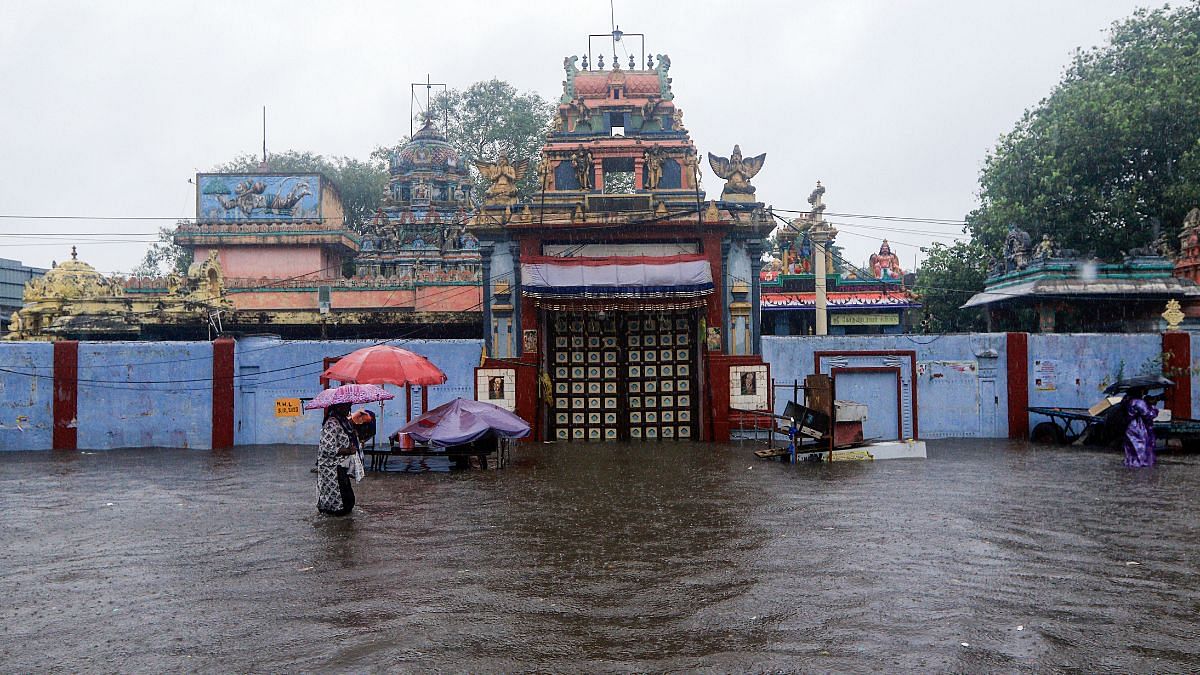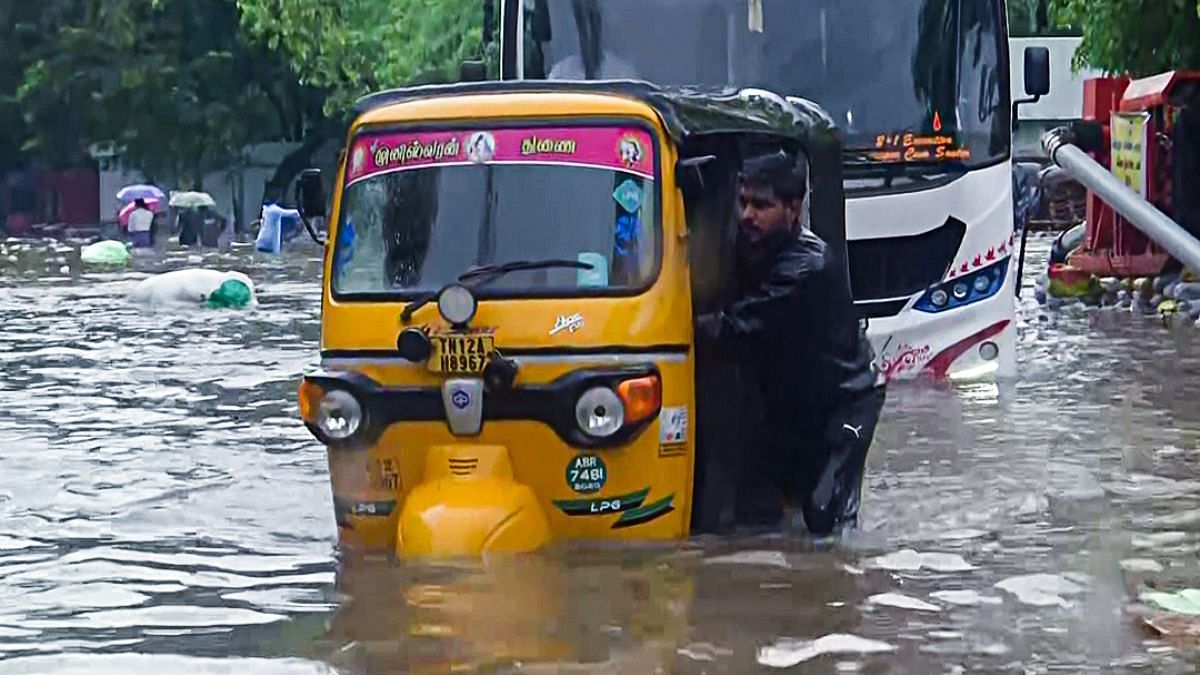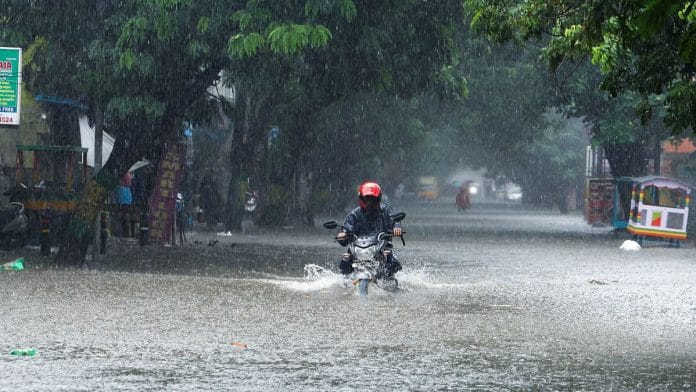Chennai: An overnight downpour Monday, followed by continuous rainfall Tuesday—as the Northeast Monsoon set in over Tamil Nadu—resulted in widespread flooding in several parts of Chennai, including Velachery, Madipakkam, Pattalam, Vyasarpadi, Perambur, Korattur, Kolathur, and Tondiar.
Waterlogging in most parts of the city was cleared by Wednesday, but a few areas, including Pattalam, Perambur, Velachery, and Madipakkam, continued to experience rainwater stagnation for the second consecutive day.
“After overnight rainfall, waterlogging on the streets caused flooding inside our house. The water level was knee-deep, and we feared it would rise further if the rain intensified, as was expected,” said A. Kumudha, a resident of AGS Nagar in Velachery, speaking to ThePrint.
Although water inside homes began to recede by Tuesday, the roads remained submerged. “We’ve been dealing with this situation ever since we moved here in 2005,” Kumudha added.
In Chennai, flooding has become almost routine whenever rainfall follows the onset of the Northeast Monsoon.
To mitigate flooding in low-lying and flood-prone areas, the Greater Chennai Corporation (GCC) constructed a stormwater drainage system with a budget of approximately Rs 5,166 crore.
On 15 October, Chennai recorded an average rainfall of 13 cm—well below the 20-cm capacity that the drainage system is designed to handle, as claimed by corporation officials. And although the average rainfall was recorded as 13 cm, parts of Chennai, Tiruvallur and Kancheepuram districts witnessed heavy rainfall of over 20 cm, resulting in waterlogging, and flooding inside the houses.
Experts and activists say mitigating the issue overnight is not possible, given geography, the faulty design of the city and the adverse climate conditions.
Geo analytical expert Raj Bhagat Palanichamy, a senior programme manager, sustainable cities and transport, at World Resources Institute (WRI) told ThePrint that the decades of flaws cannot be corrected in one go and it would take decades still to course correct the city’s design.
“At the time of expanding the city, there was no foresight regarding the situation. But the mistake is already done and it was committed over the past three decades,” Raj said. He added that constructing stormwater drains and redesigning the city’s roads by removing the existing tar and laying new roads to ensure water flows into the drains is the first step toward fixing the faulty system.
“If the process continues for at least a decade, Chennai may be able to mitigate the flood like situation in the future,” Raj said.
However, climate activist Nityanand Jayaraman said that it is impossible to mitigate the floods in Chennai if urbanisation continues.
“Even as the corrective measures are being taken, the city keeps expanding and the situation only becomes worse,” he said.
“If the government really wants to solve the problem, it must stop looking for an unlimited economy by expanding the city and redistributing the available resources to the needy,” he said, adding that even during the floods the poor and underprivileged are most affected.
After DMK came to power, in October 2022, Chennai Metropolitan Planning Area was expanded from 1,189 sq km to 5,904 sq km, including in it areas from Tiruvallur, Ranipet, Kancheepuram and Chengalpattu districts.
Taking stock of the situation in Pallikaranai locality Wednesday, Chief Minister M.K. Stalin told the media that the construction of storm water drains and the preparatory works ahead of monsoon has paid off.
“Water has drained in most of the places and the remaining places will also be drained with the help of the relentless work of the municipal administration officials,” he said.
He also assured that Chennai will soon get permanent relief after the pending storm water drainage system work is completed, as per the suggestions of the advisory committee formed in 2021 to manage and mitigate the risk of flooding in Chennai Metropolitan Area.
Storm water drains have been constructed in most parts of the city, however, linkage of storm water drains is pending at 32 locations, where the corporation has deployed motor pumps to remove the stagnant waters during the first spell of Northeast Monsoon.
The advisory committee for mitigation and management of flood risk in Chennai Metropolitan Area was formed under the leadership of former IAS officer V. Thiruppugazh.
The committee has been studying the pattern of the rains and the floods in the city and recommending measures to mitigate the floods.
Also read: Heavy rain batters Chennai & Bengaluru. Is this year’s Northeast Monsoon an aberration
Flood and waterlogging a norm in Chennai
On 15 October, waterlogging could be witnessed on Stephenson Road—one of the main roads connecting Perambur, Pattalam in North Madras—even though the rainfall there was moderate to average.
“We have been receiving the weather alert constantly, but we are well aware that water would seep into our house anytime if there is heavy rain in the night,” said A. Panneerselvam, a resident of Pattalam in Central Chennai.
Speaking to ThePrint, MLA P.K. Sekar Babu, elected from Chennai Harbour constituency under which Pattalam falls, said that his government has been working to resolve the issue in the locality for the past 3 years.
“As a person belonging to the constituency, I have known that floodwater stagnation has happened in the locality for a long time since it is one of the low-lying areas. Ever since DMK came to power, we have been working to resolve the issue and we have proposed to construct a drain at a cost of Rs 25 crore,” he said.
Residents of Pulianthope, Purasawalkam, and Vyasarpadi in North Chennai frequently suffer from waterlogging, even after moderate rainfall, with stagnant water taking at least two days to recede.
“The government keeps saying they have constructed storm water drains investing crores of rupees, but we wonder where those drains are constructed,” said D. Kamali, a resident of Purasawalkam area that saw waterlogging in its interior roads, which subsided Wednesday morning.
The areas that are worst-affected due to the heavy rainfall are those in low-lying areas, closer to the water bodies. According to a source at the GCC, the average level of land in Chennai is just 2 metres above the mean sea level, which is causing water stagnation on roads and flooding in the city.

“Only storm water drains could be an effective solution to prevent water stagnation on roads,” the official said.
Stormwater drains are installed on roads with a minimum width of 7 metres, with each drain measuring at least 600×750 millimeters.
“However, the size of the drains varies according to the locality. The aim of such drains is to relieve the water stagnation on the roads, irrespective of the length of the road,” the source added.
However, the source also noted that storm water drains can only drain the water through the gradient road.
“When there is heavy rain in a short span of time, there are practical problems and it takes time for the water to recede into the drains,” the source said.
Chennai has a mix of British-era and modern stormwater drains. However, the older drains are being demolished wherever increased capacity is needed. In the early 2000s, the Tamil Nadu state government, with assistance from the Union government, began constructing new stormwater drains.
Since then, the Greater Chennai Corporation (GCC) has built a total of 3,331.19 km of stormwater drains. This includes 767 km in North Chennai’s Tiruvottiyur, Madhavaram, and Manali areas, which flow into the Kosasthalaiyar river basin; and 406 km in Ambattur, Alandur, and Valasaravakkam, which flow into the Adyar and Cooum basins.
There are 33 canals maintained by GCC, and 16 maintained by the Public Works Department, which act as flood water carriers from roads to Kosasthalaiyar, Adyar and Cooum rivers and later drains into the Bay of Bengal.
An IAS officer who worked in the GCC, told ThePrint that the storm water drains are not a one stop solution as parts of the city often witnesses more than the average rainfall.
“Even if the storm water drains are functional, sometimes with the amount of rainfall, we tend to deploy pumps to flush out the water from one side of the stagnated place to the other side of the road, where it would recede into the drains,” the IAS officer said on condition of anonymity.

Deputy Chief Minister Udhayanidhi Stalin, who has been actively assessing the situation and directing officials to clear stagnant water since Tuesday night, told the media that their concerted efforts have paid off.
He also acknowledged that there is pending work which will be completed as early as possible.
The GCC is prioritising a massive tree plantation drive this year with the aim to plant approximately 2.5 lakh trees across Chennai. It also plans to establish 31 new sponge parks this fiscal year. Sponge parks are open urban spaces designed with pond-like structures that absorb excess water to prevent flooding and enhance groundwater recharge. In these parks, a small pond-like excavation is created in low-lying areas to divert surplus water. Additionally, pipes are installed to filter the water and promote groundwater replenishment.
What Chennai needs to counter waterlogging, floods
According to WRI’s Raj Bhagat, Chennai is no different from Bengaluru or Delhi, where urbanisation has happened at a fast pace.
“But what is making Chennai unique is its geographical vulnerability. While other cities are comfortable, Chennai is closer to the sea, and it is just 2 metres above the sea level. The flat terrain and the tidal effects make it difficult to drain the stagnated waters,” he said.
To alleviate flood-like situations, Bhagat recommended addressing four key layers of issues: technical, planning, finance, and governance.
According to him, the construction of storm water drains and the design of roads are the technical problems.
“Whenever a new road is constructed, it is being laid over the existing one, thus increasing the height of the road. So, when height of one road is increased, it makes it difficult for the water to drain and flow into the storm water drains, if they are set on high-altitude roads,” Raj said, adding that planning would also come into this since construction of stormwater drains and roads would be done effectively only if planned futuristically.
Regarding finance, he said that municipal administrations cannot consistently secure the substantial funding needed each year to invest in stormwater drains or any flood-related projects.
“But governance issues could be solved, if the responsibility and the powers of the local body elected representatives and the government officials are marked well and they are empowered to take action in the city’s planning,” he said, adding that if the state government’s action on this match the pace of urbanisation, then, in at least a decade, Chennai could see a no-flood situation.
Activist Nityanand Jayaraman, however, reiterated that the government’s ever-continuing expansion is a challenge.
“There must be a limit for everything. The water can recede only in two ways. One through the empty spaces, where the water is absorbed into the ground and another way is through the drains. But, in the fully urbanised city, there are no empty spaces for the ground to absorb the water, and all the water must go in a small drain, which is not possible,” Nityanand said.
(Edited by Zinnia Ray Chaudhuri)
Also read: Gujarat flooded, eastern India parched & no ‘monsoon breaks’. IMD predictions hit the mark






